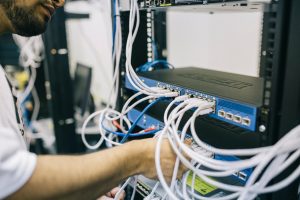artificial intelligence is infiltrating Wall Street at unprecedented speed. Whether it’s asset allocation, risk evaluation, or real-time trading decisions, AI is quickly becoming the “super brain” behind global investors. But here’s the question: Can AI truly outperform the market? And might it also bring systemic risk?
This article breaks down how AI is changing the stock market—from its core technologies and applications to how investors should adjust their strategies. We base this on the latest trends in the U.S. and European markets.
1. How Is AI Participating in the Stock Market?
1.1 High-Frequency and Algorithmic Trading
As of 2025, AI-powered algorithmic trading accounts for over 60% of total U.S. stock market volume. Compared to human traders, AI can execute commands in milliseconds and spot micro-arbitrage opportunities.
Real-world example: Goldman Sachs’ AI trading team leveraged NLP (Natural Language Processing) to analyze sentiment in Federal Reserve meeting transcripts in late 2024, adjusting positions with remarkable accuracy.
1.2 Portfolio Optimization
AI combines hundreds of macro and micro factors—interest rates, inflation, industry growth, earnings reports—through machine learning to dynamically optimize portfolios. Unlike traditional models like Markowitz’s, AI offers adaptive flexibility.
1.3 Sentiment and News Analysis
Large language models like ChatGPT, combined with financial semantic engines, are widely used by hedge funds to scan social media, headlines, and regulatory statements for early shifts in market sentiment.
2. How Is Market Structure Changing with AI?
2.1 Greater Volatility
AI systems often make similar decisions, potentially amplifying volatility. In mid-2024, the Nasdaq experienced a flash crash attributed to synchronized AI strategy triggers, prompting regulator scrutiny.
2.2 Widening the Gap for Retail Investors
AI systems require high-frequency data, computing power, and modeling capabilities that most retail investors lack—exacerbating information asymmetry.
2.3 “Black Box” Concerns
The opacity of some AI models makes it difficult for investors to understand decision logic. A misjudgment could cause a cascading systemic failure.
3. What Should Investors Do to Adapt?
3.1 Understand AI, Don’t Worship It
AI is a tool—not a magic bullet. Learn its underlying mechanisms and watch for risks like overfitting, data bias, or black swan events.
3.2 Embrace Human-AI Collaboration
Top-performing institutions often use hybrid models, blending quantitative AI input with experienced human judgment. For instance, Morgan Stanley uses AI-generated recommendations as advisory input, but human analysts have the final say.
3.3 Invest in AI Infrastructure
Besides using AI-driven funds, consider investing in the broader AI ecosystem—AI chip makers (e.g., NVIDIA), cloud platforms (e.g., AWS, Azure), and AI data service providers.
4. How Are U.S. and EU Regulators Responding?
As of 2025, both the U.S. SEC and Europe’s ESMA are drafting AI-specific trading regulations focused on:
- Requiring “explainability” for AI models
- Mandating stress-testing for AI trading systems
- Imposing rate limits during volatile markets
- Establishing accountability for AI-driven misfires
The UK’s Financial Conduct Authority (FCA) also launched a financial AI sandbox to allow safe testing of trading models in a controlled environment.
5. AI in Stocks: Trends from 2025 to 2030
| Trend | Description |
|---|---|
| Widespread AI Stock Selection | By 2028, over 80% of global institutional investors will partially rely on AI for stock picking. |
| ESG Integration | AI will incorporate ESG scores and emissions data to build optimized green portfolios. |
| Sentiment-Driven Trading | Combining ChatGPT-level analysis and semantic networks from social platforms will power the next generation of sentiment trading. |
| RegTech Adoption | AI will play a larger role in anti-money laundering (AML), fraud detection, and manipulation surveillance. |
FAQ: AI and the Stock Market in 2025
Q1: Can AI really beat human investors in the stock market?
A1: In some areas, yes—AI can process massive data faster and react to market signals in milliseconds. But it still struggles with black swan events, policy interpretation, and emotional nuance. The best results often come from human-AI collaboration.
Q2: Is AI-based trading safe for retail investors?
A2: Not entirely. Many retail platforms offer “AI-enhanced” features, but full-scale algorithmic trading typically requires institutional-level data and infrastructure. Retail investors should use AI as a tool, not a crutch.
Q3: How do hedge funds use AI in 2025?
A3: Hedge funds use AI for everything from high-frequency trading and portfolio optimization to sentiment analysis across news, Twitter, and earnings calls. Some even train proprietary language models for financial predictions.
Q4: Will AI increase or reduce market volatility?
A4: Both. AI can reduce human error and improve liquidity. But if too many AI systems react to the same signals, it can trigger flash crashes or herd behavior—something regulators are closely watching.
Q5: Are there any AI-focused stocks worth watching?
A5: Yes—tech giants like NVIDIA, AMD, and cloud providers (Amazon AWS, Microsoft Azure) benefit from AI growth. Also keep an eye on fintech firms developing AI trading tools or financial data analytics.
Q6: Can AI predict stock market crashes?
A6: AI can detect risk patterns and warning signs faster than humans, but it cannot perfectly predict crashes. Sudden geopolitical events or policy shifts still remain outside most models’ predictive ability.
If you’re a retail investor, what do these trends mean? It means you must proactively understand AI—not to compete with it, but to dance with it.



